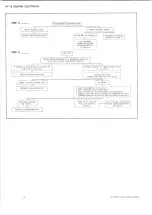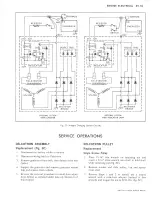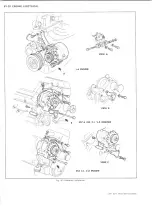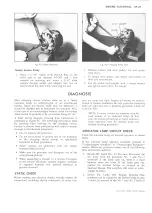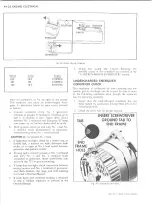
E N G I N E E L E C T R IC A L
6 Y -7
Fig. 13b—Sparks or Flames
SAFETY PRECAUTIONS
When Energizers are being charged, an explosive gas
mixture forms in each cell. Part of this gas escapes
through the holes in the vent plugs and may form an
explosive atmosphere around the energizer itself if
ventilation is poor. This explosive gas may remain in or
around the energizer for several hours after it has been
charged. Sparks or flames can ignite this gas causing an
internal explosion which may shatter the energizer (Fig.
13b).
The following precautions should be observed to prevent
an explosion:
1. Do not smoke near energizers being charged or
which have been very recently charged.
2. Do not break live circuits at the terminals of
energizers because a spark usually occurs at the
point where a live circuit is broken. Care must
always be taken when connecting or disconnecting
booster leads or cable clamps on fast chargers. Poor
connections are a common cause of electrical arcs
which cause explosions.
CHARGING PROCEDURES
Before charging an energizer the electrolyte level must
be checked and adjusted if needed. Energizer charging
consists of applying a charge rate in amperes for a
period of time in hours. Thus, a 10-ampere charge rate
for seven hours would be a 70 ampere-hour (A.H.)
charging input to the battery. Charging rates in the three
to 50 ampere range are generally satisfactory. No
particular charge rate or time can be specified for.an
energizer due to the following factors:
1
. The size, or electrical capacity in ampere-hours
(A.H.), of the Energizer.
EXAMPLE: A completely discharged 70 A.H.
energizer requires almost twice the recharging as a
40 A.H. energizer.
2. Temperature of the energizer electrolyte.
EXAMPLE About two hours longer will be needed to
charge a 0°F. energizer than a 80°F. energizer.
3. Energizer state-of-charge at the start of the
charging period.
EXAMPLE: A completely discharged energizer
requires twice as much charge in ampere-hours as a
one-half charged energizer.
Energizer age and condition.
EXAMPLE: An energizer that has been subjected to
severe service will require up to 50% more ampere-
hour charging input than a relatively new energizer.
The following basic rule applies to any energizer
charging situation:
“Any energizer may be charged at any rate in amperes
for as long as spewing of electrolyte due to violent
gassing does not occur, and for as long as electrolyte
temperature does not exceed 125°F. If spewing of
electrolyte occurs, or if electrolyte temperature exceeds
120°F., the charging rate in amperes must be reduced or
temporarily halted to avoid damage to the Energizer.
The energizer is fully charged when over a two-hour
period at a low charging rate in amperes all cells are
gassing freely (not spewing liquid electrolyte), and no
change in specific gravity occurs. The full charge specific
gravity is 1.260-1.280, corrected for electrolyte tempera
ture with the electrolyte level at the split ring, unless
electrolyte loss has occuried due to age or overfilling in
which case the specific gravity reading will be lower. For
the most satisfactory charging, the lower charging rates
in amperes are recommended.
If after prolonged charging a specific gravity of at least
1.230 on all cells cannot be reached, the battery is not in
an optimum condition and will not provide optimum
performance; however, it may continue to provide
additional service if it has performed satisfactorily in the
past.
An “emergency boost charge”, consisting of a high
charging rate for a short period of time, may be applied
as a temporary expedient in order to crank an engine.
However, this procedure usually supplies insufficient
energizer reserve to crank a second and third time.
Therefore, the “emergency boost charge” must be
followed by a subsequent charging period of sufficient
duration to restore the battery to a satisfactory state of
charge. Refer to the charging guide in this section.
When out of the vehicle, the sealed side terminal battery
will require adapters (Fig. 14b) for the terminals to
provide a place for attachment of the charging leads.
Adapters are available through local parts service.
When the side terminal battery is in the vehicle, the
studs provided in the wiring harness are suitable for
attachment of the charger’s leads.
CAUTION:
Exercise care when attaching
charger leads to side terminal studs to avoid
contact with vehicle metal components which
would result in damage to the energizer.
LIGHT DUTY TRUCK SERVICE MANUAL
Summary of Contents for Light Duty Truck 1973
Page 1: ......
Page 4: ......
Page 6: ......
Page 53: ...HEATER AND AIR CONDITIONING 1A 27 LIGHT DUTY TRUCK SERVICE MANUAL...
Page 115: ...LIGHT DUTY TRUCK SERVICE M A N U A L HEATER AND AIR CONDITIONING 1A 89...
Page 123: ...BODY 1B 3 Fig 6 Typical 06 Van LIGHT DUTY TRUCK SERVICE MANUAL...
Page 149: ...BODY 1B 29 Fig 84 Body Mounting 06 Fig 85 Body Mounting 14 LIGHT DUTY TRUCK SERVICE MANUAL...
Page 171: ...LIGHT DUTY TRUCK SERVICE M A N U A L Fig 2 Frame Horizontal Checking Typical FRAME 2 3...
Page 173: ...LIGHT DUTY TRUCK SERVICE M A N U A L Fig 4 10 30 Series Truck Frame FRAME 2 5...
Page 174: ...2 6 FRAME LIGHT DUTY TRUCK SERVICE MANUAL Fig 5 Underbody Reference Points G Van...
Page 185: ...FRONT SUSPENSION 3 11 Fig 16 Toe out on Turns LIGHT DUTY TRUCK SERVICE MANUAL...
Page 224: ......
Page 266: ......
Page 351: ...ENGINE 6 15 Fig ID Sectional View of Eight Cylinder Engine LIGHT DUTY TRUCK SERVICE MANUAL...
Page 375: ...EN G IN E 6 39 LIGHT DUTY TRUCK SERVICE MANUAL...
Page 376: ...6 4 0 ENGINE LIGHT DUTY TRUCK SERVICE MANUAL...
Page 377: ...ENG IN E 6 41 LIGHT DUTY TRUCK SERVICE MANUAL...
Page 378: ...LIGHT DUTY TRUCK SERVICE MANUAL Fig 37L K Series Engine Front Mount 6 42 ENG INE...
Page 400: ...6 6 4 ENG INE LIGHT DUTY TRUCK SERVICE MANUAL...
Page 401: ...ENG IN E 6 65 LIGHT DUTY TRUCK SERVICE MANUAL...
Page 402: ...6 6 6 ENGINE LIGHT DUTY TRUCK SERVICE MANUAL...
Page 403: ...E NG IN E 6 67 Fig 36V C Series Engine Mounts LIGHT DUTY TRUCK SERVICE MANUAL...
Page 410: ......
Page 423: ...EN G IN E C OOLING 6K 13 Fig 16 Overheating Chart LIGHT DUTY TRUCK SERVICE MANUAL...
Page 424: ...6 K 1 4 ENG INE COOLING Fig 17 Coolant Loss Chart LIGHT DUTY TRUCK SERVICE MANUAL...
Page 456: ...6M 32 ENGINE FUEL Fig K15 Accelerator Controls G Van L 6 LIGHT DUTY TRUCK SERVICE MANUAL...
Page 492: ......
Page 512: ...Fig 18e Vacuum Advance Diagram V8 Engine...
Page 516: ...6 T 2 4 E M IS S IO N CONTROL SYSTEMS LIGHT DUTY TRUCK SERVICE MANUAL...
Page 528: ......
Page 590: ......
Page 593: ...CLUTCHES MANUAL TRANSMISSIONS 7M 3 LIGHT DUTY TRUCK SERVICE MANUAL...
Page 598: ...7M 8 CLUTCHES MANUAL TRANSMISSIONS LIGHT DUTY TRUCK SERVICE MANUAL...
Page 642: ......
Page 654: ......
Page 743: ...FUEL TANKS AND EXHAUST 8 13 LIGHT DUTY TRUCK SERVICE MANUAL...
Page 744: ...8 14 FUEL TANKS AND EXHAUST LIGHT DUTY TRUCK SERVICE MANUAL...
Page 760: ...8 30 FUEL TANKS AND EXHAUST Fig 40 Exhaust Pipe P Models LIGHT DUTY TRUCK SERVICE MANUAL...
Page 761: ...FUEL TANKS AND EXHAUST 8 31 LIGHT DUTY TRUCK SERVICE MANUAL...
Page 763: ...FUEL TANKS AND EXHAUST 8 33 LIGHT DUTY TRUCK SERVICE MANUAL...
Page 766: ......
Page 832: ...LIGHT DUTY TRUCK SERVICE MANUAL Fig 106 Power Steering Pump Mounting Typical 9 66 STEERING...
Page 833: ...PUMP ASSEMBLY STEERING GEAR TYPICAL SMALL V8 TYPICAL LARGE V8 STEERING 9 67...
Page 861: ...STEERING 9 95 Fig 134 Power Steering Pump Leakage LIGHT DUTY TRUCK SERVICE MANUAL...
Page 864: ......
Page 876: ......
Page 886: ...11 10 CHASSIS SHEET METAL LIGHT DUTY TRUCK SERVICE MANUAL...
Page 891: ...ELECTRICAL BODY AND CHASSIS 12 5 LIGHT DUTY TRUCK SERVICE MANUAL...
Page 934: ......
Page 942: ......
Page 970: ......
Page 972: ......
Page 974: ......
Page 976: ...V...
Page 978: ......
Page 979: ......
























